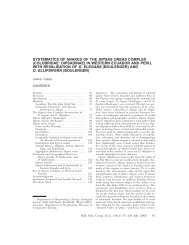cryptic species within the dendrophidion vinitor complex in middle ...
cryptic species within the dendrophidion vinitor complex in middle ...
cryptic species within the dendrophidion vinitor complex in middle ...
Create successful ePaper yourself
Turn your PDF publications into a flip-book with our unique Google optimized e-Paper software.
SPECIES IN THE DENDROPHIDION VINITOR COMPLEX N Cadle 195<br />
Figure 4. A typical posterior body pattern of Dendrophidion<br />
<strong>v<strong>in</strong>itor</strong> (AMNH R-66845). Section is from <strong>the</strong> posterior third of<br />
<strong>the</strong> body. The vertebral row is marked by a whitish l<strong>in</strong>e<br />
punctuated with larger blotches at <strong>the</strong> position of pale<br />
crossbands which, on <strong>the</strong> posterior body, are ma<strong>in</strong>ly restricted<br />
to a dorsolateral position and heavily <strong>in</strong>vested with<br />
dark pigment.<br />
Fig. 3B). Venter yellowish to whitish and<br />
immaculate except for lateral dark pigment.<br />
Most juveniles have more dist<strong>in</strong>ct pale<br />
crossbands on <strong>the</strong> posterior body than do<br />
adults, and <strong>in</strong> general, <strong>the</strong>ir patterns are<br />
more contrast<strong>in</strong>g than those <strong>in</strong> adults<br />
(Fig. 3D).<br />
Distribution (Fig. 5). Central Veracruz<br />
state, Mexico, eastward to sou<strong>the</strong>astern<br />
Guatemala and sou<strong>the</strong>rn Belize. Dendrophidion<br />
<strong>v<strong>in</strong>itor</strong> occurs on <strong>the</strong> Atlantic and<br />
Pacific versants of <strong>the</strong> Isthmus of Tehuantepec<br />
but o<strong>the</strong>rwise appears to be restricted<br />
to <strong>the</strong> Atlantic versant. The nor<strong>the</strong>rnmost<br />
record is from Las M<strong>in</strong>as, Veracruz (Pérez-<br />
Higareda and Smith, 1991), assum<strong>in</strong>g I have<br />
identified <strong>the</strong> locality correctly. Recorded<br />
elevations for specimens I exam<strong>in</strong>ed are<br />
lowland (,100 m) to about 800 m on <strong>the</strong><br />
slopes of Volcán San Martín <strong>in</strong> sou<strong>the</strong>rn<br />
Veracruz (most localities 400–600 m), with<br />
<strong>the</strong> s<strong>in</strong>gle Belize specimen from slightly<br />
higher, between 940 and 1,035 m (see<br />
Appendix 2, Little Quartz Ridge).<br />
Several historical records of D. <strong>v<strong>in</strong>itor</strong><br />
deserve comment because <strong>the</strong>y document<br />
localities from which no recent specimens<br />
are available. Dugés (1892; ‘‘Dendrophidium<br />
dendrophis’’) gave a detailed description and<br />
color illustration of a specimen from Motzorongo,<br />
Veracruz, which leaves little doubt<br />
about its identity as D. <strong>v<strong>in</strong>itor</strong>. Specimens<br />
from Guatemala are scarce, and I am aware<br />
of only two specimens obta<strong>in</strong>ed s<strong>in</strong>ce <strong>the</strong><br />
holotype was collected <strong>in</strong> 1939 (Appendix 1),<br />
despite considerable biological <strong>in</strong>ventory of<br />
that country (e.g., Duellman, 1963; Stuart,<br />
1963; Campbell, 1998). There has been<br />
controversy about <strong>the</strong> orig<strong>in</strong> and identity of<br />
several specimens obta<strong>in</strong>ed <strong>in</strong> Guatemala<br />
dur<strong>in</strong>g <strong>the</strong> 19th century (see synonymy<br />
under <strong>the</strong> names Drymobius dendrophis<br />
and Dendrophidion dendrophis).<br />
Duméril et al. (1870–1909: 730–732)<br />
reported a specimen obta<strong>in</strong>ed by Arthur<br />
Morelet from ‘‘Peten’’ and two o<strong>the</strong>rs (‘‘seen<br />
alive,’’ collector not <strong>in</strong>dicated) from ‘‘Vera<br />
Figure 5. Distribution of Dendrophidion <strong>v<strong>in</strong>itor</strong> <strong>in</strong> sou<strong>the</strong>rn Mexico, Guatemala, and Belize. A few symbols represent multiple<br />
contiguous localities. Arrow <strong>in</strong>dicates <strong>the</strong> type locality.<br />
Bullet<strong>in</strong> of <strong>the</strong> Museum of Comparative Zoology harv-160-04-01.3d 11/4/12 19:58:47 195







